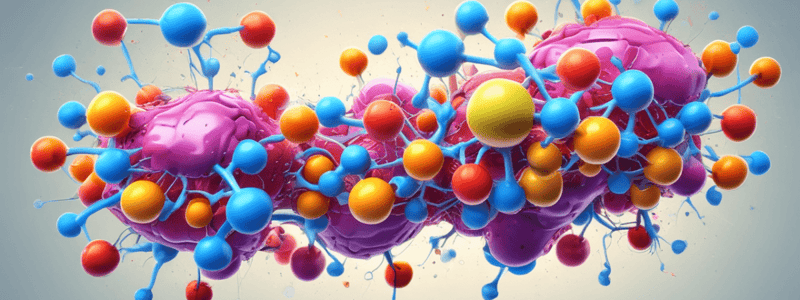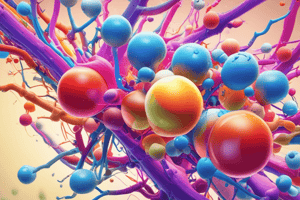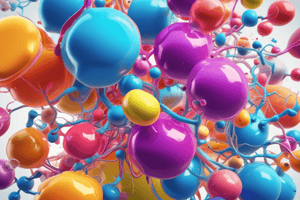Podcast
Questions and Answers
What type of reactions synthesize molecules with more bonds and higher free energy products?
What type of reactions synthesize molecules with more bonds and higher free energy products?
- Anabolic reactions (correct)
- Catabolic reactions
- Kinetic reactions
- Thermodynamic reactions
Which concept states that energy transformation always results in a loss of usable energy through entropy?
Which concept states that energy transformation always results in a loss of usable energy through entropy?
- Enzyme Specificity
- Protein Structure
- First and Second Laws of Thermodynamics (correct)
- Free Energy Transfer
What is the function of enzymes in a reaction?
What is the function of enzymes in a reaction?
- Inhibit the reaction
- Decrease the free energy change
- Reduce the activation energy (correct)
- Increase the activation energy
Which factor determines the specificity and function of enzymes?
Which factor determines the specificity and function of enzymes?
In which type of reaction are molecules broken down to make lower free energy products?
In which type of reaction are molecules broken down to make lower free energy products?
What does the difference in free energy, ∆G, between reactants and products determine in a reaction?
What does the difference in free energy, ∆G, between reactants and products determine in a reaction?
What is the role of allosteric effectors in enzyme regulation?
What is the role of allosteric effectors in enzyme regulation?
How is ATP primarily involved in reaction coupling?
How is ATP primarily involved in reaction coupling?
What process involves the loss of electrons from molecules?
What process involves the loss of electrons from molecules?
In redox reactions, what is the role of NADH (or NADPH)?
In redox reactions, what is the role of NADH (or NADPH)?
What is a common feature of catabolic reactions compared to anabolic reactions?
What is a common feature of catabolic reactions compared to anabolic reactions?
When do negative feedback loops inhibit an enzyme in a metabolic pathway?
When do negative feedback loops inhibit an enzyme in a metabolic pathway?
Which type of reaction degrades molecules to make lower free energy products?
Which type of reaction degrades molecules to make lower free energy products?
What is the function of enzymes in a reaction?
What is the function of enzymes in a reaction?
Which concept involves the transformation of energy always resulting in a loss of usable energy through entropy?
Which concept involves the transformation of energy always resulting in a loss of usable energy through entropy?
In an enzyme-substrate complex, substrates interact with enzymes at the:
In an enzyme-substrate complex, substrates interact with enzymes at the:
Which type of reactions synthesize molecules with more bonds and higher free energy products?
Which type of reactions synthesize molecules with more bonds and higher free energy products?
What determines the specificity and function of enzymes?
What determines the specificity and function of enzymes?
What is the chemical energy available to do work and expressed as the difference between enthalpy and entropy?
What is the chemical energy available to do work and expressed as the difference between enthalpy and entropy?
When do negative feedback loops inhibit an enzyme in a metabolic pathway?
When do negative feedback loops inhibit an enzyme in a metabolic pathway?
What involves a change in free energy, delta G, between reactants and products in a reaction?
What involves a change in free energy, delta G, between reactants and products in a reaction?
Which factor indicates if a reaction is positive or negative delta G?
Which factor indicates if a reaction is positive or negative delta G?
Which statement best describes the second law of thermodynamics?
Which statement best describes the second law of thermodynamics?
What is the primary role of ATP in reaction coupling?
What is the primary role of ATP in reaction coupling?
Which of the following statements about anabolic and catabolic reactions is correct?
Which of the following statements about anabolic and catabolic reactions is correct?
Which of the following best describes the role of allosteric effectors in enzyme regulation?
Which of the following best describes the role of allosteric effectors in enzyme regulation?
Which of the following statements about free energy diagrams is correct?
Which of the following statements about free energy diagrams is correct?
What is the primary role of NADH (or NADPH) in metabolic reactions?
What is the primary role of NADH (or NADPH) in metabolic reactions?
Which of the following statements about entropy is correct?
Which of the following statements about entropy is correct?
What is the primary function of negative feedback loops in metabolic pathways?
What is the primary function of negative feedback loops in metabolic pathways?
Which of the following statements about oxidation and reduction is correct?
Which of the following statements about oxidation and reduction is correct?
Which of the following statements about enzymes is correct?
Which of the following statements about enzymes is correct?
Flashcards
What is the allosteric site?
What is the allosteric site?
The allosteric site is a region on the enzyme where a molecule, called an allosteric effector (can be either an activator or inhibitor), binds to and alters the shape of the enzyme. This binding can either activate or inhibit the enzyme's activity.
What are metabolic pathways?
What are metabolic pathways?
Metabolic pathways are a series of interconnected chemical reactions that take place in cells and involve the conversion of one molecule into another. They are regulated at different steps in the process depending on the cell's needs and the availability of energy.
How do negative feedback loops work?
How do negative feedback loops work?
Negative feedback loops help to regulate metabolic pathways by ensuring that the cell doesn't produce too much of a particular product. This is achieved by using the product of the pathway to inhibit an enzyme early in the pathway.
State the First and Second Laws of Thermodynamics.
State the First and Second Laws of Thermodynamics.
Signup and view all the flashcards
What is free energy (G)?
What is free energy (G)?
Signup and view all the flashcards
What is the change in free energy (∆G)?
What is the change in free energy (∆G)?
Signup and view all the flashcards
What are enzymes?
What are enzymes?
Signup and view all the flashcards
How are enzyme specificity and function determined?
How are enzyme specificity and function determined?
Signup and view all the flashcards
What is the active site on an enzyme?
What is the active site on an enzyme?
Signup and view all the flashcards
What is reaction coupling?
What is reaction coupling?
Signup and view all the flashcards
How does ATP hydrolysis contribute to reaction coupling?
How does ATP hydrolysis contribute to reaction coupling?
Signup and view all the flashcards
What are oxidation and reduction?
What are oxidation and reduction?
Signup and view all the flashcards
What are NADH and NADPH?
What are NADH and NADPH?
Signup and view all the flashcards
What are anabolic reactions?
What are anabolic reactions?
Signup and view all the flashcards
What are catabolic reactions?
What are catabolic reactions?
Signup and view all the flashcards
What is metabolism?
What is metabolism?
Signup and view all the flashcards
Explain the First Law of Thermodynamics.
Explain the First Law of Thermodynamics.
Signup and view all the flashcards
Explain the Second Law of Thermodynamics.
Explain the Second Law of Thermodynamics.
Signup and view all the flashcards
Describe anabolic reactions in terms of energy, entropy, and building or breaking.
Describe anabolic reactions in terms of energy, entropy, and building or breaking.
Signup and view all the flashcards
Describe catabolic reactions in terms of energy, entropy, and building or breaking.
Describe catabolic reactions in terms of energy, entropy, and building or breaking.
Signup and view all the flashcards
What is a free energy diagram and what does it show?
What is a free energy diagram and what does it show?
Signup and view all the flashcards
How do enzymes affect the rate of a reaction and the free energy change (∆G)?
How do enzymes affect the rate of a reaction and the free energy change (∆G)?
Signup and view all the flashcards
How are enzymes regulated within cells?
How are enzymes regulated within cells?
Signup and view all the flashcards
Study Notes
Regulation of Enzymes and Metabolic Pathways
- Enzymes can be regulated by allosteric effectors that bind to the allosteric site, altering the shape of the protein to either inhibit or activate enzyme function.
- Metabolic pathways can be regulated at different steps depending on the demands of the cell.
- Negative feedback loops use the product of a pathway to inhibit an enzyme at the beginning of the pathway.
Thermodynamics and Energy Transformations
- The First and Second Laws of Thermodynamics state that energy is transformed in many ways, but always at a cost of energy lost through entropy.
- Free energy (G) is chemical energy available to do work and is expressed as the difference between enthalpy (total energy) and entropy.
- Any reaction involves a change in free energy, ∆G, between reactants and products.
- The direction of change in free energy tells if it is positive or negative ∆G (anabolic or catabolic).
Enzymes and Reaction Coupling
- Enzymes are proteins that reduce the activation energy of a reaction.
- Enzyme specificity and function are the result of the structure (shape) of the protein.
- Substrates interact with enzymes at the active site, forming an enzyme-substrate complex with a close interaction through induced fit.
- Reaction coupling combines a positive ∆G reaction with a negative ∆G reaction to give a new net negative ∆G for the combined reactions.
- The most common means of reaction coupling is to use the hydrolysis of ATP, yielding a ∆G = -7.3 kcal/mole, to generate phosphorylated intermediate molecules of higher energy.
Redox Reactions and Energy Transfer
- Oxidation is the loss of electrons and reduction is the gain of electrons by molecules.
- NADH (or NADPH) is a commonly used high energy electron carrier in metabolism.
- It captures high energy electrons from organic molecules and holds on to them for later when energy from those electrons can be extracted bit by bit using an electron transport chain to do work.
Anabolic and Catabolic Reactions
- Anabolic reactions synthesize or "build" molecules with more bonds, making higher free energy products.
- They use or store energy (endergonic), reduce entropy, and are non-spontaneous.
- Catabolic reactions degrade or "break" molecules to make lower free energy products with fewer bonds.
- They increase entropy and release energy (exergonic), and are spontaneous.
Metabolism and Cellular Processes
- Metabolism is the sum of all anabolic and catabolic reactions in a cell, connected in a network of reaction pathways.
- You should be able to define the first and second laws of thermodynamics and recognize energy transformations and changes in entropy in cellular processes.
- Compare and contrast anabolic and catabolic reactions in terms of change in free energy, change in entropy, if they are spontaneous, and if they are endergonic and exergonic.
- Recognize and explain free energy diagrams for negative and positive delta G reactions.
- Explain the function of enzymes in relation to their structure and their role in negative delta G reactions, and discuss how enzymes are regulated in cells.
Studying That Suits You
Use AI to generate personalized quizzes and flashcards to suit your learning preferences.




